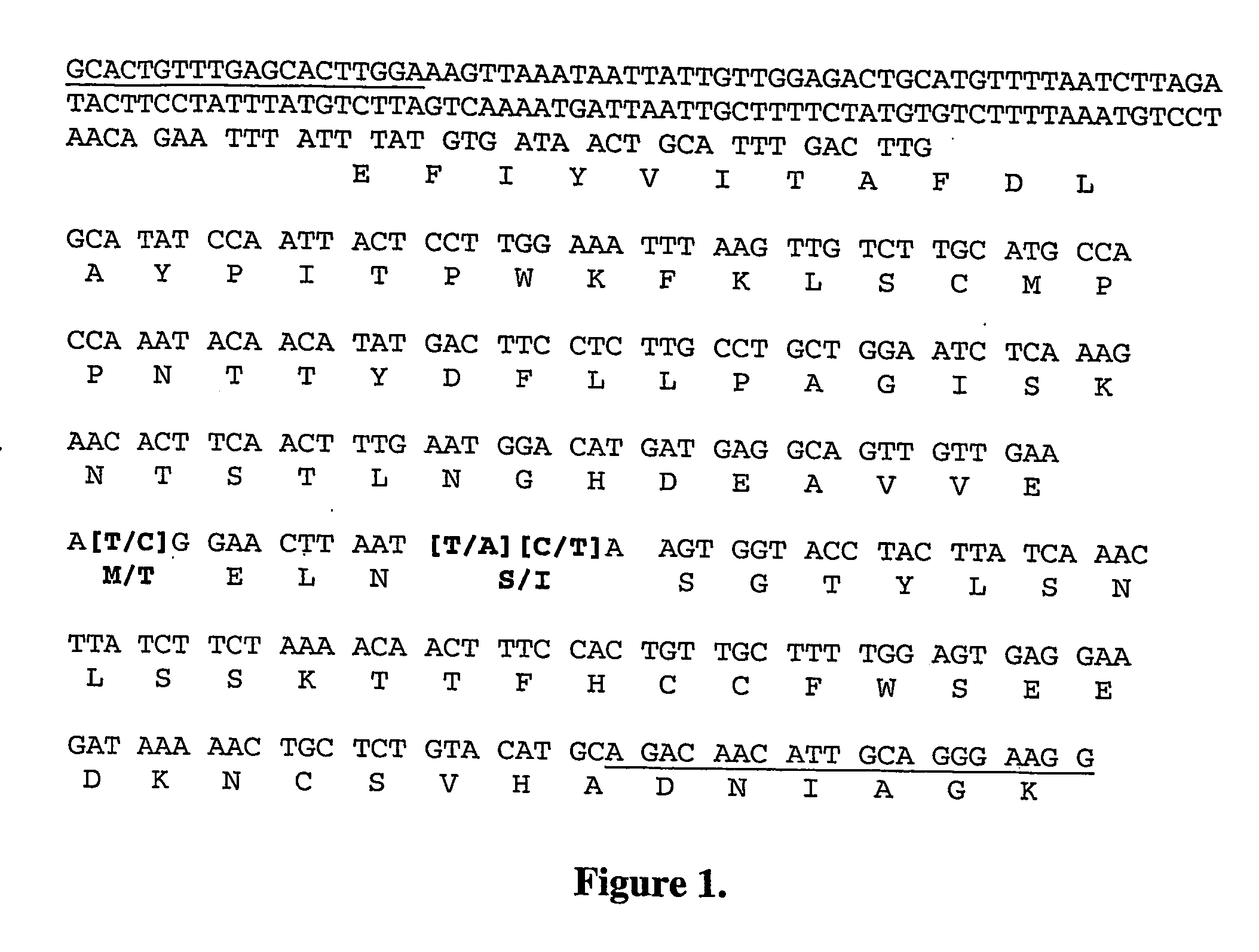Use of single nucleotide polymorphism in the coding region of the porcine leptin receptor gene to enhance pork production
a technology of leptin receptor and coding region, which is applied in the direction of microorganism testing/measurement, biochemistry apparatus and processes, etc., can solve the problems of significant health hazards, low heritability of desired traits, and high risk of cardiovascular disease, so as to increase the frequency of leptin gene alleles, increase meat production, and improve the effect of the gene allele frequency
- Summary
- Abstract
- Description
- Claims
- Application Information
AI Technical Summary
Benefits of technology
Problems solved by technology
Method used
Image
Examples
example 1
Characterization of the “C” / “T” Polymorphism in Swine
[0098] PCR primers, corresponding to SEQ ID NO:4 and SEQ ID NO:5, were designed to amplify a portion of the LEPR gene containing a small intron and the beginning of the coding region. The primers were used as part of a PCR reaction using the DNA from 18 animals as template. The resultant amplicons were sequenced and analyzed for polymorphisms. This analysis resulted in the identification of a polymorphism at nucleotide 299 of the amplicon (corresponding to position 609 of Genbank accession AF184173, SEQ ID NO:3).
[0099] The set of 18 animals used for polymorphism discovery were from a first (“Line A”; Pietrain) and a second (“Line B”; Duroc) commercial line. DNA was extracted from either ear or tail tissue using commercially available DNA extraction materials (Qiagen N.V., Venlo, Netherlands). DNA was subjected to PCR amplification using oligonucleotide primers SEQ ID NO: 4 and SEQ ID NO: 5. Amplified fragments were sequenced in ...
example 2
Discovery of SNPs in Close Proximity to LEPR
[0100] PCR primers were designed from a portion of the complete coding sequence of pLEPR (SEQ ID NO:11) from a porcine EST sequence that was in close proximity to pLEPR on a porcine radiation hybrid map (SEQ ID NO:13) and from a porcine EST sequence that was homologous to a sequence obtained from the human sequence map and in close proximity to human LEPR (SEQ ID NO:15). These PCR primers (SEQ ID NO:35-40) were used to screen BAC clones from a porcine bacterial artificial chromosome library (RPCI-44 see bacpac.chori.org / mporcine44.htm) and select a clone representing each sequence / locus (BAC clones 069P03, 036M15, and 335C21, respectively). These three BAC clones were then subcloned and approximately 48 subclones were randomly selected and sequenced. High quality subclone sequences that did not contain known porcine repetitive elements were then selected for another round of primer design. Due to the fact that only partial and often times...
example 3
Methods for Genotyping the T69M Locus
[0105] Several methods exist to determine allelic composition at the LEPR T69M polymorphism. Such methods include, but are not limited to, PCR amplification and sequencing using SEQ ID NO: 4 and SEQ ID NO: 5 or other suitable primer pairs consisting of DNA sequence flanking the polymorphism, RFLP analysis using amplification primers SEQ ID NO: 1 and SEQ ID) NO: 2 or other suitable primers flanking the polymorphism in conjunction with a restriction endonuclease such as BsrDI or other suitable enzyme to discriminate between the “C” and “T” alleles in the amplified DNA, real time PCR analyses (TAQMAN®) involving DNA amplification and probe hybridization where the hybridization probes are labeled and discriminate between the allelic forms, and other methods readily performed by those skilled in the art (see Table 4).
TABLE 4Fwd Primer5′-TTCAACTTTGAATGGACATGATGAG-3′(SEQ ID NO: 6)rev Primer5′-GTGGAAAGTTGTTTTAGAAGATAAGTTTGA-3′(SEQ ID NO: 7)vicProbe5′-...
PUM
| Property | Measurement | Unit |
|---|---|---|
| Frequency | aaaaa | aaaaa |
| Thermal stability | aaaaa | aaaaa |
| Acid number | aaaaa | aaaaa |
Abstract
Description
Claims
Application Information
 Login to view more
Login to view more - R&D Engineer
- R&D Manager
- IP Professional
- Industry Leading Data Capabilities
- Powerful AI technology
- Patent DNA Extraction
Browse by: Latest US Patents, China's latest patents, Technical Efficacy Thesaurus, Application Domain, Technology Topic.
© 2024 PatSnap. All rights reserved.Legal|Privacy policy|Modern Slavery Act Transparency Statement|Sitemap


